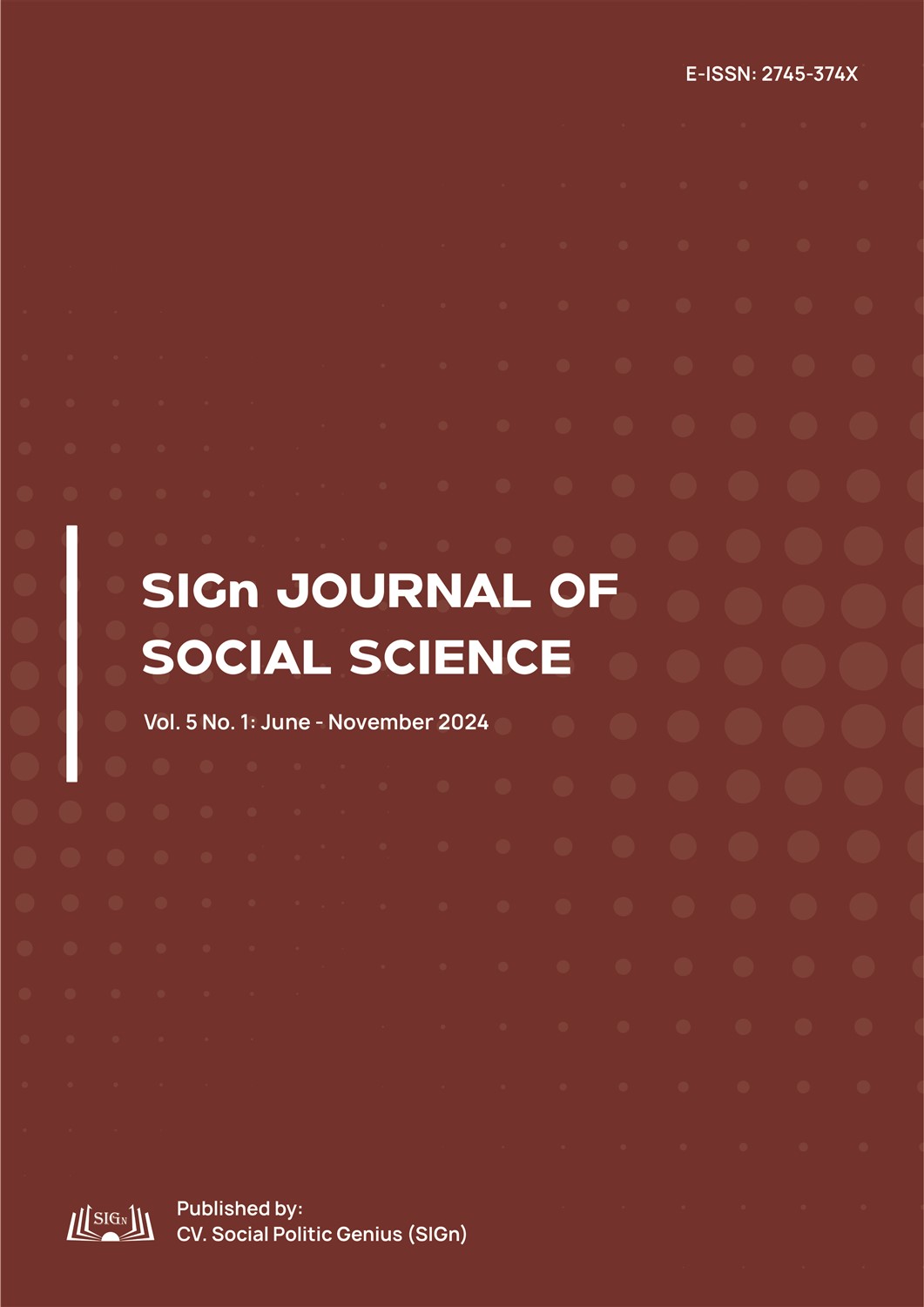Community Identification and Response to the Threat of Terrorism in Makassar City
Abstract
Terrorism is a complex global threat, and understanding community responses to this threat is crucial. This qualitative case study aims to explore in-depth the identification and responses of the Makassar City community to the threat of terrorism, particularly following the bombing in front of the Cathedral. Research data was obtained through in-depth interviews with residents, community leaders, religious figures, and security officials, as well as analysis of documents and media reports. The results show that the Makassar City community identifies terrorist group characteristics through factual knowledge and stereotypes. This identification process also involves analyzing the responses of certain groups to government policies and maintaining awareness of the potential for issue manipulation by political elites. Furthermore, the mass media plays a significant role in shaping public perceptions and responses. This research confirms that inaccurate identification can trigger stigmatization and discrimination. Community responses to government policies and local political dynamics become important indicators in identifying potential terrorist movements. In conclusion, community identification of and response to the threat of terrorism is a dynamic and multidimensional process requiring a comprehensive and participatory approach to prevention efforts.
Downloads
References
Campedelli, G. M., Cruickshank, I., & Carley, K. M. (2023). Multi-Modal Networks Reveal Patterns of Operational Similarity of Terrorist Organizations. Terrorism and Political Violence, 35(5), 1065-1084. https://doi.org/10.1080/09546553.2021.2003785
Coser, L. A. (1956). The Functions of Social Conflict. Free Press.
Eldridge, J. B. (2020). E. Stanley Jones: Sharing the Good News in a Pluralistic Society. Methodist History, 58(1-2), 114-115. https://doi.org/10.5325/methodisthist.58.1-2.0114
Feyyaz, M., & Bari, S. H. (2024). A Critical Analysis of India and Pakistan’s Terrorism Discourse in the Context of Geopolitics and Imperialism. Critical Studies on Terrorism, 17(3), 606-630. https://doi.org/10.1080/17539153.2024.2360274
Filippo, M. D. (2020). The Definition(s) of Terrorism in International Law. In B. Saul (Ed.), Research Handbook on International Law and Terrorism (pp. 2-15). Edward Elgar Publishing. https://doi.org/10.4337/9781788972222.00008
Galtung, J. (1969). Violence, Peace, and Peace Research. Journal of Peace Research, 6(3), 167-191. https://doi.org/10.1177/002234336900600301
Government Regulation in Lieu of Law of the Republic of Indonesia Number 1 of 2002 on the Eradication of Criminal Act of Terrorism (State Gazette of the Republic of Indonesia of 2002 Number 106, Supplement to the State Gazette of the Republic of Indonesia Number 4232). https://peraturan.go.id/id/perppu-no-1-tahun-2002
Gramsci, A. (1971). Selections from the Prison Notebooks. International Publishers.
Hobson, R. B., & Moghadam, A. (2024). Terrorism, Guerrilla, and the Labeling of Militant Groups. Terrorism and Political Violence, 36(4), 567-584. https://doi.org/10.1080/09546553.2023.2183052
Law of the Republic of Indonesia Number 15 of 2003 on Enactment of Government Regulation in Lieu of Law Number 1 of 2002 on the Eradication of Criminal Act of Terrorism Into Law (State Gazette of the Republic of Indonesia of 2003 Number 45, Supplement to the State Gazette of the Republic of Indonesia Number 4284). https://www.dpr.go.id/dokumen/jdih/undang-undang/detail/198
Law of the Republic of Indonesia Number 5 of 2018 on Amendment to Law Number 15 of 2003 on Enactment of Government Regulation in Lieu of Law Number 1 of 2002 on the Eradication of Criminal Act of Terrorism Into Law (State Gazette of the Republic of Indonesia of 2018 Number 92, Supplement to the State Gazette of the Republic of Indonesia Number 6216). https://www.dpr.go.id/dokumen/jdih/undang-undang/detail/1712
Lu, P., Zhang, Z., Li, M., Chen, D., & Yang, H. (2020). Agent-Based Modeling and Simulations of Terrorist Attacks Combined with Stampedes. Knowledge-Based Systems, 205, 1-13. https://doi.org/10.1016/j.knosys.2020.106291
Marua, A., & Muzakkir, A. K. (2023). Fajar.co.id Political Reporting: A Study on Editorial Policy Related to the Makassar Mayoral Election. SIGn Journal of Social Science, 3(2), 75-87. https://doi.org/10.37276/sjss.v3i2.324
Matussa’dah, H., Hidayatullah, A., & Hermanto, L. (2022). Persepsi Masyarakat Kelurahan Penatoi Tentang Stigmatisasi Kelurahan Penatoi Sebagai Kampung Teroris. Jurnal Komunikasi dan Kebudayaan, 9(2), 58-68. https://doi.org/10.59050/jkk.v9i2.184
Miyarso, E. (2011). Pengembangan Model Internalisasi Nilai-Nilai Pendidikan Agama Sebagai Upaya untuk Menangkal Potensi Terorisme dan Gejala Disintegrasi Bangsa. Jurnal Penelitian Humaniora, 16(1), 76-93. https://doi.org/10.21831/hum.v16i1.3421
Muzakkir, A. K. (2015). Keberpihakan Media Televisi dalam Pemberitaan Calon Presiden Menjelang Pilpres 2014 [Unpublished Bachelor Thesis]. Universitas Hasanuddin.
Neuman, W. L. (2003). Metodologi Penelitian Sosial: Pendekatan Kualitatif dan Kuantitatif, Trans. by E. T. Sofia. PT. Indeks.
Nikoghosyan, H., & Ter-Matevosyan, V. (2023). From ‘Revolution’ to War: Deciphering Armenia’s Populist Foreign Policy-Making Process. Southeast European and Black Sea Studies, 23(2), 207-227. https://doi.org/10.1080/14683857.2022.2111111
Piatkowska, S. J., & Stults, B. J. (2022). Brexit, Terrorist Attacks, and Hate Crime: A Longitudinal Analysis. Social Problems, 69(4), 968-996. https://doi.org/10.1093/socpro/spab005
Roele, I. (2022). Style Management: Images of Global Counter-Terrorism at the United Nations. Law and Critique, 33(3), 273-297. https://doi.org/10.1007/s10978-022-09330-5
Romadhon, S., & Saputra, A. W. (2021). Humor Sebagai Strategi Moderasi Umat Beragama Pascateror Bom Makasar 2021. Tatar Pasundan: Jurnal Diklat Keagamaan, 15(2), 154-165. https://doi.org/10.38075/tp.v15i2.231
Sukabdi, Z. A. (2021). Psychological Risk Factors of Terrorist Offenders in Indonesia. Journal of Psychological Research, 3(4), 1-15. https://doi.org/10.30564/jpr.v3i4.3748
Whitney, F. L. (1960). The Elements of Research. Prentice-Hall, Inc.
Xue, J., Raitt, J., Roaten, K., & North, C. S. (2022). A Study of Suicidal Thoughts and Behaviour in a Sample of Adults Affected by the 9/11 Attacks on New York City’s World Trade Center. International Review of Psychiatry, 34(1), 89-96. https://doi.org/10.1080/09540261.2021.2018996
Zayas, D. d., & Matusitz, J. (2021). Understanding the Dissemination of ISIS Beheading Videos Through the Diffusion of Innovations (DoI) Theory. Journal of Policing, Intelligence and Counter Terrorism, 16(3), 205-222. https://doi.org/10.1080/18335330.2021.1892168
Copyright (c) 2024 Arham Ichwardani Sanusi

This work is licensed under a Creative Commons Attribution 4.0 International License.


.jpg)













